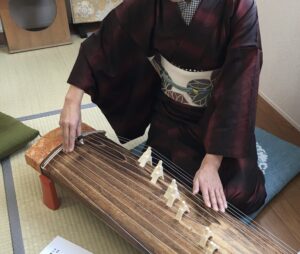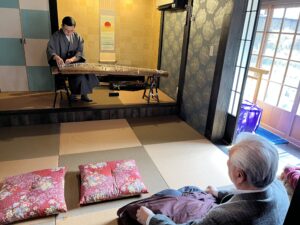Few instruments embody the grace and refinement of Japanese culture quite like the koto (箏). With its long, polished wooden body and shimmering strings, this traditional zither has been the soundtrack to Japan’s history for over a millennium—from imperial courts to modern concert halls.
For travelers seeking an authentic cultural experience, the koto offers more than just beautiful music; it’s a gateway to understanding Japan’s artistic soul. Let’s explore why this instrument remains one of Japan’s most treasured cultural icons.
A Brief History: From Imperial Courts to Modern Japan
The koto was introduced to Japan from China during the Nara Period (710–794) and quickly became a centerpiece of gagaku, the music of the imperial court. By the Edo Period (1603–1868), it had spread beyond the aristocracy, becoming a popular instrument among merchants, geisha, and even samurai.
Today, the koto bridges tradition and modernity. While classical pieces like “Rokudan no Shirabe” are still performed, contemporary artists fuse koto music with jazz, rock, and electronic sounds—proving that this ancient instrument is anything but stuck in the past.
Why Is the Koto Considered So Elegant?
 1. Its Exquisite Design
1. Its Exquisite Design
Crafted from paulownia wood (kiri), the koto’s long, slender body is both simple and sophisticated. The 13 strings, traditionally made of silk (now often nylon), stretch across movable bridges called ji, allowing for precise tuning.
When played, the koto’s polished wood gleams, and the strings produce a sound that is:
- Clear yet warm – Like water flowing over smooth stones.
- Dynamic – Capable of both powerful melodies and delicate whispers.
- Hypnotic – Its resonance lingers in the air, creating a meditative atmosphere.
2. The Graceful Art of Playing
Koto players wear tsume (plectra) on their fingers, plucking the strings with precise, fluid motions. The left hand presses and bends strings to create subtle pitch variations, adding emotional depth to each note.
Watching a skilled koto performer is mesmerizing—every movement is deliberate, every note intentional. It’s no wonder the koto was historically associated with refinement and nobility.
3. Its Role in Japanese Aesthetics
The koto embodies wabi-sabi—the appreciation of imperfection and transience. Its music evokes:
- The tranquility of a Zen garden.
- The fleeting beauty of cherry blossoms.
- The melancholy of autumn evenings.
Where Can You Experience the Koto?
 🎶 Live Performances
🎶 Live Performances
- Koto Live Performance in Hiroshima – It’s open almost every day.
- Kyoto’s tea houses – Many offer intimate koto performances with matcha.
- Tokyo’s concert halls – Look for shows by renowned players like Michiyo Yagi.
- Cultural festivals – Especially during Obon or New Year celebrations.
🎼 Try Playing It Yourself!
If you’re visiting Hiroshima, Koto Workshop offers hands-on sessions where you can:
✔ Learn the basics in just one lesson.
✔ Play a traditional song like “Sakura Sakura.”
✔ Discover the instrument’s cultural significance.
(No prior experience needed—just a sense of adventure!)
Why Every Traveler Should Listen to the Koto
- A Cultural Masterpiece – Few instruments capture Japan’s history so beautifully.
- Deeply Relaxing – Its soothing tones are perfect for unwinding after sightseeing.
- A Unique Story – Imagine telling friends you played a 1,300-year-old instrument!
Final Thoughts: The Timeless Allure of the Koto
The koto is more than just an instrument—it’s a living symbol of Japanese elegance. Whether you listen to a performance in a Kyoto tea house or try playing it yourself in Hiroshima, the koto offers an unforgettable connection to Japan’s artistic heritage.
Want to experience it firsthand?
👉 Join a koto workshop in Hiroshima today!
